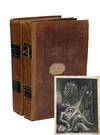first edition Hardcover
1831
by Shelley, Mary; Schiller, Friedrich; Brown, Charles Brockden.
London: Colburn and Bentley, 1831 Two volumes: No. IX with Frankenstein (complete) and Ghost Seer (Vol. 1); No. X with Ghost Seer (Vol. 2) and Edgar Huntley (complete). Illustrated by Theodor von Holst and engraved by William Chevalier. First illustrated edition, first printing, third edition overall. Publisher's brown boards, black labels with gilt lettering to spines, Frankenstein and The Ghost Seer with frontispiece and title page illustrations, cream endpapers. Very good unsophisticated set with minor rubbing and soiling to exterior, toning to spines and edges, a bit of cloth separation to rear hinges of both volumes, some spotting and offsetting to frontispiece and title page, light foxing to a few pages, some loss to spine labels on No. IX (bottom label is missing the "S" in "Standard" and the top label is split vertically down the center and missing a few letters), No. IX's spine with a slight lean, bookseller's ticket to center of No. IX's front board, previous owner's signature to front pastedown of No. X, and Barbavilla House bookplates to front pastedown of both volumes. Overall, an attractive and sturdy set, without any repair, and an important and early edition of one of the greatest works of 19th century literature. Sadleir 3734a; Wolff 6280a. For this 1831 edition of Frankenstein, published after the 1818 and 1823 editions, Mary Shelley heavily revised the text, softening some of the more radical elements of the novel, and emphasizing fatalism as a guiding principle for the actions of her characters rather than free will. It has been theorized that the latter change was made in response to a series of tragic deaths of Shelley's family members and friends in the years between 1818 and 1831 that gave her a more pessimistic view of the universe and its uncontrollable forces. This edition's revised text is the most popular and widely read version of the story today. Shelley also added an introduction, in which she describes how the story of Frankenstein came to be, and removed the Paradise Lost epitaph that was on the title page of the 1818 edition: "Did I request thee, Maker, from my clay / To mould me man? Did I solicit thee / From darkness to promote me?" This edition of Frankenstein, the first to be illustrated, includes two scenes by British literary painter Theodor von Holst, one of which captures the dramatic moment when Frankenstein's monster awakens from death. It was released as a part of the "Standard Novels" series, an extremely successful series published by Colburn and Bentley that has been described as a "landmark in 19th century publishing." The series' popularity was due to its affordable prices, and its offering of novels in single volumes that had previously been available only in multi-volume form. . First Edition. Hard Cover. Near Fine.
(Inventory #: MWS005)








